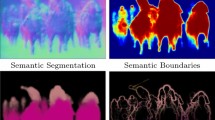Abstract
Deep Convolutional Neural Networks (CNNs) have recently begun to exhibit human level performance on some visual perception tasks. Performance remains relatively poor, however, on some vision tasks, such as object detection: specifying the location and object class for all objects in a still image. We hypothesized that this gap in performance may be largely due to the fact that humans exhibit selective attention, while most object detection CNNs have no corresponding mechanism. In examining this question, we investigated some well-known attention mechanisms in the deep learning literature, identifying their weaknesses and leading us to propose a novel attention algorithm called the Densely Connected Attention Model. We then measured human spatial attention, in the form of eye tracking data, during the performance of an analogous object detection task. By comparing the learned representations produced by various CNN architectures with that exhibited by human viewers, we identified some relative strengths and weaknesses of the examined computational attention mechanisms. Some CNNs produced attentional patterns somewhat similar to those of humans. Others focused processing on objects in the foreground. Still other CNN attentional mechanisms produced usefully interpretable internal representations. The resulting comparisons provide insights into the relationship between CNN attention algorithms and the human visual system.
Access this chapter
Tax calculation will be finalised at checkout
Purchases are for personal use only
Similar content being viewed by others
References
Brainard, D.H., Vision, S.: The psychophysics toolbox. Spat. Vis. 10, 433–436 (1997)
Ebrahimpour, M.K., et al.: Ventral-dorsal neural networks: object detection via selective attention. In: WACV (2019)
Erhan, D., Bengio, Y., Courville, A., Vincent, P.: Visualizing higher-layer features of a deep network. Univ. Montreal 1341(3), 1 (2009)
Everingham, M., Van Gool, L., Williams, C.K.I., Winn, J., Zisserman, A.: The PASCAL visual object classes (VOC) challenge. Int. J. Comput. Vis. 88(2), 303–338 (2010)
Nguyen, A., Yosinski, J., Clune, J.: Multifaceted feature visualization: uncovering the different types of features learned by each neuron in deep neural networks. arXiv preprint arXiv:1602.03616 (2016)
O’Reilly, R.C., Munakata, Y.: Computational Explorations in Cognitive Neuroscience: Understanding the Mind by Simulating the Brain. MIT Press, Cambridge (2000)
Rajaei, K., Mohsenzadeh, Y., Ebrahimpour, R., Khaligh-Razavi, S.M.: Beyond core object recognition: Recurrent processes account for object recognition under occlusion, p. 302034 (2018). bioRxiv
Rumelhart, D.E., McClelland, J.L.: Parallel Distributed Processing: Explorations in the Microstructure of Cognition. Volume 1: Foundations. MIT Press, Cambridge (1986)
Selvaraju, R.R., Cogswell, M., Das, A., Vedantam, R., Parikh, D., Batra, D.: Grad-CAM: visual explanations from deep networks via gradient-based localization. In: ICCV (2017)
Simonyan, K., Vedaldi, A., Zisserman, A.: Deep inside convolutional networks: visualising image classification models and saliency maps. arXiv preprint arXiv:1312.6034 (2013)
Simonyan, K., Zisserman, A.: Very deep convolutional networks for large-scale image recognition. arXiv preprint arXiv:1409.1556 (2014)
Springenberg, J.T., Dosovitskiy, A., Brox, T., Riedmiller, M.: Striving for simplicity: the all convolutional net. arXiv preprint arXiv:1412.6806 (2014)
Yamins, D.L.K., Hong, H., Cadieu, C.F., Solomon, E.A., Seibert, D., DiCarlo, J.J.: Performance-optimized hierarchical models predict neural responses in higher visual cortex. Proc. Natl. Acad. Sci. 111(23), 8619–8624 (2014)
Yosinski, J., Clune, J., Nguyen, A., Fuchs, T., Lipson, H.: Understanding neural networks through deep visualization. arXiv preprint arXiv:1506.06579 (2015)
Zeiler, M.D., Fergus, R.: Visualizing and understanding convolutional networks. In: ECCV (2014)
Zhou, B., Khosla, A., Lapedriza, A., Oliva, A., Torralba, A.: Learning deep features for discriminative localization. In: CVPR (2016)
Author information
Authors and Affiliations
Corresponding author
Editor information
Editors and Affiliations
Rights and permissions
Copyright information
© 2019 Springer Nature Switzerland AG
About this paper
Cite this paper
Ebrahimpour, M.K., Falandays, J.B., Spevack, S., Noelle, D.C. (2019). Do Humans Look Where Deep Convolutional Neural Networks “Attend”?. In: Bebis, G., et al. Advances in Visual Computing. ISVC 2019. Lecture Notes in Computer Science(), vol 11845. Springer, Cham. https://doi.org/10.1007/978-3-030-33723-0_5
Download citation
DOI: https://doi.org/10.1007/978-3-030-33723-0_5
Published:
Publisher Name: Springer, Cham
Print ISBN: 978-3-030-33722-3
Online ISBN: 978-3-030-33723-0
eBook Packages: Computer ScienceComputer Science (R0)




